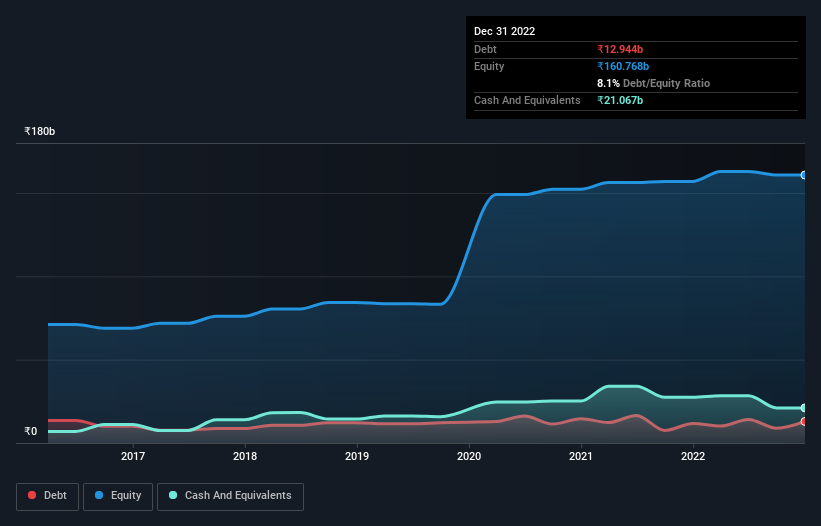Is Tata Consumer Products (NSE:TATACONSUM) A Risky Investment?

Legendary fund manager Li Lu (who Charlie Munger backed) once said, 'The biggest investment risk is not the volatility of prices, but whether you will suffer a permanent loss of capital.' So it seems the smart money knows that debt - which is usually involved in bankruptcies - is a very important factor, when you assess how risky a company is. Importantly, Tata Consumer Products Limited (NSE:TATACONSUM) does carry debt. But the more important question is: how much risk is that debt creating?
What Risk Does Debt Bring?
Debt and other liabilities become risky for a business when it cannot easily fulfill those obligations, either with free cash flow or by raising capital at an attractive price. Part and parcel of capitalism is the process of 'creative destruction' where failed businesses are mercilessly liquidated by their bankers. However, a more usual (but still expensive) situation is where a company must dilute shareholders at a cheap share price simply to get debt under control. Of course, the upside of debt is that it often represents cheap capital, especially when it replaces dilution in a company with the ability to reinvest at high rates of return. The first thing to do when considering how much debt a business uses is to look at its cash and debt together.
View our latest analysis for Tata Consumer Products
What Is Tata Consumer Products's Net Debt?
You can click the graphic below for the historical numbers, but it shows that as of September 2022 Tata Consumer Products had ₹12.9b of debt, an increase on ₹11.7b, over one year. However, its balance sheet shows it holds ₹21.1b in cash, so it actually has ₹8.12b net cash.

How Healthy Is Tata Consumer Products' Balance Sheet?
Zooming in on the latest balance sheet data, we can see that Tata Consumer Products had liabilities of ₹30.8b due within 12 months and liabilities of ₹16.6b due beyond that. Offsetting these obligations, it had cash of ₹21.1b as well as receivables valued at ₹16.3b due within 12 months. So it has liabilities totalling ₹10.0b more than its cash and near-term receivables, combined.
This state of affairs indicates that Tata Consumer Products' balance sheet looks quite solid, as its total liabilities are just about equal to its liquid assets. So it's very unlikely that the ₹670.3b company is short on cash, but still worth keeping an eye on the balance sheet. While it does have liabilities worth noting, Tata Consumer Products also has more cash than debt, so we're pretty confident it can manage its debt safely.
And we also note warmly that Tata Consumer Products grew its EBIT by 14% last year, making its debt load easier to handle. There's no doubt that we learn most about debt from the balance sheet. But it is future earnings, more than anything, that will determine Tata Consumer Products's ability to maintain a healthy balance sheet going forward. So if you want to see what the professionals think, you might find this free report on analyst profit forecasts to be interesting.
Finally, a business needs free cash flow to pay off debt; accounting profits just don't cut it. Tata Consumer Products may have net cash on the balance sheet, but it is still interesting to look at how well the business converts its earnings before interest and tax (EBIT) to free cash flow, because that will influence both its need for, and its capacity to manage debt. Over the last three years, Tata Consumer Products recorded free cash flow worth a fulsome 89% of its EBIT, which is stronger than we'd usually expect. That positions it well to pay down debt if desirable to do so.
Summing Up
We could understand if investors are concerned about Tata Consumer Products's liabilities, but we can be reassured by the fact it has has net cash of ₹8.12b. The cherry on top was that in converted 89% of that EBIT to free cash flow, bringing in ₹9.4b. So we don't think Tata Consumer Products's use of debt is risky. Above most other metrics, we think its important to track how fast earnings per share is growing, if at all. If you've also come to that realization, you're in luck, because today you can view this interactive graph of Tata Consumer Products's earnings per share history for free.
At the end of the day, it's often better to focus on companies that are free from net debt. You can access our special list of such companies (all with a track record of profit growth). It's free.
Valuation is complex, but we're here to simplify it.
Discover if Tata Consumer Products might be undervalued or overvalued with our detailed analysis, featuring fair value estimates, potential risks, dividends, insider trades, and its financial condition.
Access Free AnalysisHave feedback on this article? Concerned about the content? Get in touch with us directly. Alternatively, email editorial-team (at) simplywallst.com.
This article by Simply Wall St is general in nature. We provide commentary based on historical data and analyst forecasts only using an unbiased methodology and our articles are not intended to be financial advice. It does not constitute a recommendation to buy or sell any stock, and does not take account of your objectives, or your financial situation. We aim to bring you long-term focused analysis driven by fundamental data. Note that our analysis may not factor in the latest price-sensitive company announcements or qualitative material. Simply Wall St has no position in any stocks mentioned.
About NSEI:TATACONSUM
Tata Consumer Products
Produces, distributes, and trades in food products in India, the United States, the United Kingdom, and internationally.
Flawless balance sheet established dividend payer.


